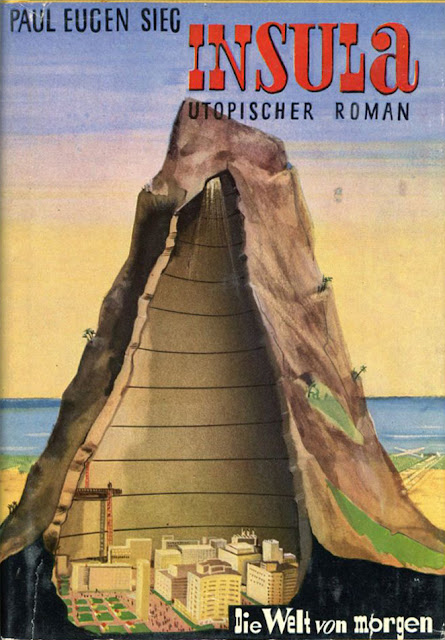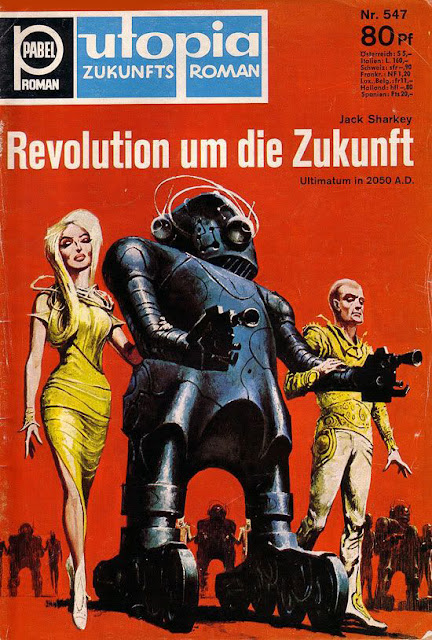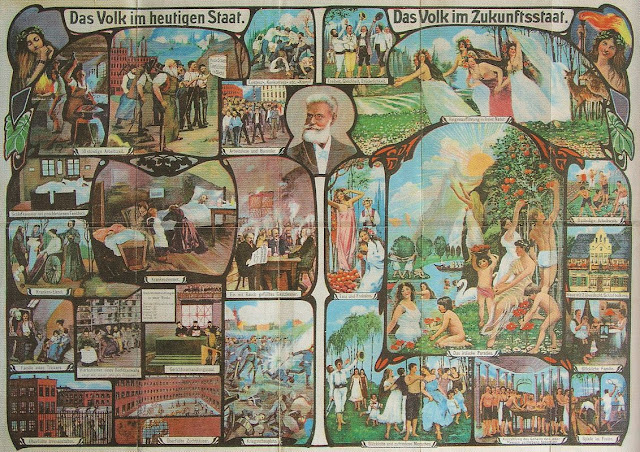Tellers of Weird Tales turned ten years old last week. I first wrote on April 22, 2011. My first entry was on C.L. Moore (1911-1987), who grew up in the same neighborhood in Indianapolis in which I grew up, though half a century before. Being from Indiana and having the pride of a Hoosier in me, I took a special interest in her. In the year before beginning this blog, I began writing an article about her. That article was finally published in the summer of 2019 in Traces, the magazine of the Indiana Historical Society. Its working title was "The Weird and Wondrous Fiction of C.L. Moore." It went to print as "Amazing Tales: The Weird and Wondrous Fiction of C.L. Moore." It's because of my research and writing on C.L. Moore, too, that I have a place on the Internet Speculative Fiction Database (ISFDb), but that's for a different article I wrote, published by Paco Arrelano. I'm not a member of the ISFDb, so I'm not sure that I can add to it. I hope someone will add my article from Traces on my behalf. I would also like to hear from Señor Arrelano in hopes that I can get a copy of his magazine Delirio in which my article appeared.
Although C.L. Moore was the subject of my first entry on this blog, she wasn't the reason for my starting it. The impetus actually came while I was reading Weird Tales: The Magazine That Never Dies, edited by Marvin Kaye (1988). Included in that book is the first Damp Man story by Allison V. Harding. Mr. Kaye's introduction to "The Damp Man" is brief, for at the time almost nothing was known about the pseudonymous Harding. But here in front of me was a mystery, one I was determined to solve. I began on April 26, 2011, ten years ago today. I solved the mystery less than a month later, on May 24, 2011, with my entry entitled "Who Was Allison V. Harding?"
The answer to that question was and is Jean Milligan (1919-2004), later the wife of the former associate editor and art editor of Weird Tales magazine, Lamont Buchanan (1919-2015). And now I see that I have to update my entry on the late Mr. Buchanan. Anyway, I have to admit that I was a little hard on Marvin Kaye for the part he played in the Weird Tales debacle of a few years back, but I also have to thank him for the part he unknowingly played in getting this blog off the ground. I have to reassert, too, that I am the person who discovered the identity of Allison V. Harding and Jean Milligan. No one else did that, and no one else should be taking credit for the discovery or pretending like it's something that just fell out of the sky. (This is where the passive voice, mostly a scourge, comes in handy. In using it, you don't have to say that somebody did something, only that something happened, no doer necessary.) Anyway, I did it. I discovered the identity of Allison V. Harding. It's my work. I expect to be cited for it. And I have this to say to people who like to glom on to the work of others: if you want to be known for your work, then do your work. Get up and do it and don't thieve it from others. And once you have done it, publish it, however you can. Get it out there into the world.
* * *
There has been some controversy recently about Allison V. Harding and Jean Milligan. I might have been a little responsible for that, too, by suggesting that Lamont Buchanan was actually the writer behind the pseudonym. The controversy comes from the idea that we're all trying to take something away from women writers, that somehow we're anti-woman and that we want to erase them and silence them. That isn't my idea at all. In fact, it's closer to the opposite. (Should I point out here that the first three authors and five out of the first ten about whom I wrote on this blog were women?)
My idea that Lamont Buchanan was Allison V. Harding came to me as I was reading the last Damp Man story, "The Damp Man Again," from Weird Tales, May 1949. As I was reading, it occurred to me that this was not the work of a woman, for no woman would write about another woman in this way. Only a man--a bitter and angry man at that--could write about women with this kind of cruelty, mean-spiritedness, and misogyny, writing that has in it even intimations of psychopathy and a desire to hurt and punish women. Feminists might object to my suggestion or belief that Lamont Buchanan was Allison V. Harding, but they should first read "The Damp Man Again"--"Take the Z-Train," too--and see what they think afterwards. It's worth noting here that Lamont Buchanan was still a single man in 1949 when "The Damp Man Again" was published. He and Jean Milligan were not married until 1952, in The Bronx, where they went on to live out their lives together. By the way, there is a Harding Avenue in The Bronx. If we play a word game, then Harding Avenue can become Harding Ave. can become Harding, A.V., can become A.V. Harding . . . you get where I'm going.
* * *
There has been another recent controversy when it comes to Allison V. Harding. I wasn't the first person to have made a connection between Lamont Buchanan and J.D. Salinger (1919-2010) and Salinger's character Holden Caulfield, but I think I was the first to get it out into the world of science fiction and fantasy fandom and scholarship. I don't really believe that J.D. Salinger was Allison V. Harding, and I doubt that Buchanan and Salinger, who may have been friends in their college years, collaborated or talked to each other about writing as late as 1947 or 1949 or 1950. But you never know. There seems to be a hole in the scholarship on J.D. Salinger that hasn't been filled yet. I still want to say to all of the bored academics of this world, "Get up and get busy and forget about all of that woke BS that seemingly occupies everybody in your formerly respectable fields!" That's a little long and not very pithy for an exhortation, but you get the idea. In the meantime, the only people who seem to be interested in the idea that Buchanan was the model for Caulfield are those vying for or writing about Buchanan's estate. Money has its ways.
* * *
I have never counted the number of authors who contributed to Weird Tales. Years ago I estimated it at about 700. I had thought that by now I would be about finished with them. But in writing this blog I have gotten on to things other than biography. Biography and the discovery of lives and identities is fun, but so are other things. In any case, I'm planning to get back to some biographies soon. First I have to finish my current series, which is going on about as long as Burroughs' Mars series. I didn't want this anniversary to go by unobserved, though, and so I will let you know that Tellers of Weird Tales is ten years old in this season of discovery and beginning. I plan to continue writing, even after I go over the 1,000,000-visits mark sometime this summer, even after I have covered all of the magazine's writers and artists.
Ten years is a long time. As one of my entomology professors would say, "Time flies like an arrow and fruit flies like a banana."
Text copyright 2021, 2023 Terence E. Hanley
















